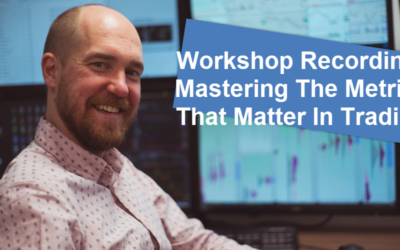2020 Trading Group Therapy Plans
We are planning to do something different for our Group Therapy sessions in 2020. . One of the reasons for this is that there’s only so much to be said about trading, we’ll start to get repetitive if we go over the same topics again. The plan is to focus on customer issues rather than us choosing the topics
For example, I am working with a trader now that has the opposite issue to most – he can’t pull the trigger. He’s undertrading. If you think about it – that’s something that journaling your trades doesn’t help much – because you aren’t making any trades. It’s also a tough one to advise on – it would be very easy to give bad advice, after all – how do you know the trader is really missing trades versus there not being much opportunity for his particular trading method on the markets he’s looking at?
You can’t just say “Trade more”.
It calls for “hands-on” work. Right now, he’s recording videos each day and uploading them so that we can review. There’s a common misconception that exiting a trade is “Bad” if the market then goes your way after the exit. But the market can only go 2 ways, so it’s likely to happen half the time. Care must be taken not to fix something that isn’t broken. I’ll be reviewing his ‘missed trades’ with him to see if he really is missing trades and we’ll figure out a ‘go-forward’ plan to address it.
This will be the topic of our first Customer Issue Focused Group Therapy. We’ll use this as the model for other Group Therapies in 2020. 1 a month. Customers will suggest topics – we’ll either pick from those ourselves OR we’ll let you vote on them if there’s too many for us to choose from. If your topic is chosen, you will need to diligently journal your trades and you will need to provide videos (we’ll guide you on that). You will also need to come to the meeting and give your side of the story. Send details of your issues, we’ll chat about your role, if it seems too much – you can bail with no hard feelings.
Before that though – I’d like to do an “Extended Directors Version” of the “Cut & Chop” webinar we did last week at Wealth365. It’s extended because we are putting in a lot more information AND we’ll split it up into 2 or 3 sessions, so we can make it more interactive. I felt that session was too compressed.
The goal of this event is to challenge a lot of the beliefs I see that many of you still hanging on to. For example – I’ve had many requests to add yesterdays volume profile to the Depth & Sales. It’s a reasonable request. With all customer requests that ask for more information used to make trading decisions, I always ask how it would be used. The answer I often get is “I find it useful”. That’s not quite the same as saying ” I believe there is a set of traders holding positions overnight that do x because of y” – I can get on board with that. What I don’t want to do is keep adding more and more ‘stuff’ to the product. The more data points you use to make a decision – the harder making that decision will be. My view is that margin rules funnel short term traders into styles that have them flat at the end of the day. My opinion is that yesterdays volume profile has no value – it’s not representative of existing positions whose holders will react in any way. I will hold that opinion until someone convinces me otherwise.
What I could do when someone says “I need it because I find it useful” is ask “Are you profitable?” and if they say no reply “It’s not useful then, is it?” but that’s right up there in the top 3 of how to upset your customers. What I can tell you is there’s things I used in trading that I found ‘useful ‘for a long time until I realized I wasn’t really using them in the heat of the moment. They were not adding value to the decision making process. Traders are odd beasts though – so I’m also open to something being your “lucky rabbits foot” that you can’t trade without.
So – we’ll go a lot deeper into a number of concepts like:
- The Dog & The Tail – The connectedness of things
- Supply and Demand zones
- Support & Resistance
- Timeframes
- Futures vs Stocks – Structural differences, differences in what causes activity
- Holding Times
- Algos/HFTs
- What we are left with
The last subject is key. A lot of people think we are completely ‘anti-chart’ at Jigsaw but sometimes there is no other data point than history. One of the reasons is that people think this is that our drills kick off focusing you only on the Depth & Sales. That’s because we are teaching you the Depth & Sales, not because you can’t use anything else again. I’ve had a few people apologize to me for ‘still using charts’.
I don’t believe in technical analysis, I think the key to trading is to understand what other people are doing, the idea that you can’t look at any history at all is not something I agree with. Sometimes there is nothing else to key a position day trade off.
Everything we talk about in these sessions will come with an explanation of why I believe it to be true. For example Demand Zones. Are large trading institutions sitting there waiting for the market to come to them when they want to buy a million shares of TSLA? And if price moves up – will they simply pass on the TSLA opportunity because it didn’t hit their price? It doesn’t make a lot of sense. If I am right and institutions are buying over a range of prices – whose orders are at that “supply zone”? And if they want to buy TSLA and price is dropping, why not wait for lower prices? Of course, there could be times when large options positions means an institution stands to lose if a price is breached – but that’s more the exception than the rule.
Also worth consideration – how can you stop the S&P Futures without stopping the SPY ETF, the 500 stocks, the options on the futures, the options on the ETF and the options on the stocks?
Anyway – all this will be covered and I really welcome you to disagree in the sessions.
In terms of availability, these sessions will be available to anyone that purchased the Advanced Training (or Institutional Training (or daytradr Professional/Institutional). The recordings will go into the Advanced Training course.
The rest of 2020’s Group Therapy Sessions (the ones focused on your issues), will be more widely available.
Feel free to start emailing details of your issues.
Simplify Your Trading
Take a look into the decision making process of professional traders with this video training series that helps you make smarter trading decisions.




0 Comments